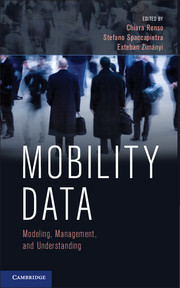Book contents
- Frontmatter
- Contents
- List of Contributors
- Preface
- Acknowledgments
- PART I MOBILITY DATA MODELING AND REPRESENTATION
- PART II MOBILITY DATA UNDERSTANDING
- PART III MOBILITY APPLICATIONS
- PART IV FUTURE CHALLENGES AND CONCLUSIONS
- 15 A Complexity Science Perspective on Human Mobility
- 16 Mobility and Geo-Social Networks
- 17 Conclusions
- Bibliography
- Glossary
- Author Index
- Subject Index
- Plate section
17 - Conclusions
from PART IV - FUTURE CHALLENGES AND CONCLUSIONS
Published online by Cambridge University Press: 05 October 2013
- Frontmatter
- Contents
- List of Contributors
- Preface
- Acknowledgments
- PART I MOBILITY DATA MODELING AND REPRESENTATION
- PART II MOBILITY DATA UNDERSTANDING
- PART III MOBILITY APPLICATIONS
- PART IV FUTURE CHALLENGES AND CONCLUSIONS
- 15 A Complexity Science Perspective on Human Mobility
- 16 Mobility and Geo-Social Networks
- 17 Conclusions
- Bibliography
- Glossary
- Author Index
- Subject Index
- Plate section
Summary
Mobility data management and analysis have emerged in the last decade as a very active research domain, promoted by academic events (e.g., several dedicated conferences, journal issues, and seminars), international R&D projects (e.g., GeoPKDD, MODAP, MOVE), and industrial initiatives (e.g., the multiple mobility contests that have been organized recently by several organizations). This book documented the richness and significance of the main research achievements in a variety of domains related to mobility data management and showed how several application domains have already benefited from these achievements. It also highlighted two very important areas for new applications related to most advanced technological environments, namely social networks and network sciences. Yet there is much room for further work in all aspects of movement analysis. The following concluding remarks aim at showing some further developments that are expected within the short-term future and that build on the mobility technologies discussed in this book.
Basic Trajectory Framework
A first evidence is that new research projects are needed to expand the scope and coverage of mobility studies, currently mainly restricted to the limited set of basic concepts described in the first chapter of this book. For example, analyzing movement of deforming areas (e.g., floods, pollution clouds, storms, diseases) has received relatively little attention up to now. Yet its economic importance is rapidly increasing as the disastrous effects of natural phenomena linked to current climate change are influencing government policies to promote better analyses of such phenomena.
- Type
- Chapter
- Information
- Mobility DataModeling, Management, and Understanding, pp. 334 - 340Publisher: Cambridge University PressPrint publication year: 2013

